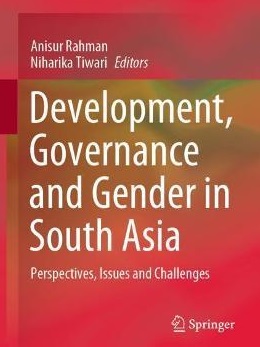
SYED ALI MUJTABA
“Development, Governance, and Gender in South Asia – Perspectives, Issues, and Challenges” is a new book on the shelf that may interest those who are keen to understand contemporary realities of the South Asian region.
It is edited by Professor Anisur Rahman, Director, UGC-Human Resource Development Centre, Jamia Millia Islamia, New Delhi, and Niharika Tiwari, Assistant Professor Department of Political Science, Deen Dayal Upadhyaya Government P.G College Saidabad, Uttar Pradesh.
The book offers a fresh, multidisciplinary and comprehensive approach to understanding the trends and issues of governance, human development, and regional cooperation in South Asia.
The book attempts to identify the factors and patterns behind the region’s persisting sluggish performance on good governance and human development indicators. It also provides country-specific and intra-country variation in the region with explanations and interpretations.
This book embroiders some of the underlying debates, related to governance, human rights, human development, human security, regional cooperation, media literature, and gender.
There is a series of research papers in the book on subjects that have been analyzed by policymakers and civil society movements. Some topics deal with the problems of narrative spun by policymakers and state authorities contrary to the ground realities.
The deconstructive and post-modernist approach is used in this book to analyze the socio-political and economic development of South Asia. This is dealt with objective analysis the concepts like development and its impact on gender, ethnicity, and religion.
The first part of the book deals with the conceptual and theoretical perspective to understand the trajectories of social and economic development in South Asia. The second part discusses the dynamics and equilibrium between governance and human rights. The third lay emphasis on the importance of media literacy and its changing dynamics in the south Asian region. The fourth part deals with gender and its changing scenario in the South Asian context.
The book is divided into several sections like; social and economic development, governance and human rights, media and literature, gender and development. Each section has a number of chapters under its head. The section on social and economic development has chapters like, ‘analyzing the status of human development in South Asia’, ‘Repositioning South Asian states: Reinforcing Human Development,’ ‘Debt, Deficit and Economic Growth in South Asia: A Comparative Analysis,’ ‘Promoting South Asian Migration to the Gulf Region: Reducing Poverty and Inequality as the Strategy,’ ‘Skills for Employability and Development in South Asia: A Comparative Analysis.’
The section on Governance and Human Rights has chapters on, ‘Governance and Capability- Contemporary Issues for Citizens and Governments,’ ‘Shrinking Space of Minorities in South Asia: A Comparative Study of India and Pakistan,’ ‘Good Governance and Human Rights: A South Asian Perspective,’ ‘Nuclear Weapons and Regional Cooperation in South Asia,’ ‘Corporate Governance in South Asian Countries: An Overview.’
The section on Media and Literature has chapters on, ‘Role of Media in Conflict Management: A Case Study of 2016 Kashmir Unrest,’ ‘The Development Narratives in South Asia: A Case Study of Print Media.’ In this literature section, there are chapters on ‘Urdu Historiography- A Field of Urdu Literature in South Asia,’ ‘Contribution of Nepali Literature to ‘New Nepal’ Building,’ and ‘Representation of Literature through Media: A Comparative Study of Bapsi Sidhwa’s ‘Ice Candy Man’ and Deepa Mehta’s ‘Earth. ’
In the section Gender and Development, there are chapters like, ‘Gendered Demonology: Women as Witches,’ ‘Masculinizing’ the Women: Strategic De/Reconstruction of Gender in the Fiction of South Asian Women Writers,’ ‘The “Third Space” of Feminist Sensibility in South Asian Diaspora Literature,’ ‘Sharing the Destiny: Women’s Political Representation in India in the South Asian Perspective.’
The editors have collected an excellent bunch of writers on the varied themes. The social and Economic Development section has contributionsfromNiharika Tiwari, D. K. Giri, Md Nizamuddin, Anisur Rahman, Aarti Srivastava, and Anjali Taneja.
The section Governance and Human Rights has contributions from R. F. I. Smith, Abdulrahim P. Vijapur, Qazi Mohammed Usman, B. L. Meena, and Syeda Sumaya Mehdi.
The section on Media and Literature has contributions from, Syeda Afshana and Heeba Din, Vijay Kumar Soni and Sadananda Sahoo, Alain Désoulières, Ramji Timalsina, and Sadaf Fareed.
The section on Gender and Development has contributions from, Farhat Nasreen, Afrinul Haque Khan, Shabina Nishat Omar, and Nabila Sadiq.
The chapters in this book broadly cover almost all relevant issues in South Asia. The state, civil society, social movements, various forms of media, and their role in the formation, as well as the deconstruction of the power structure, are discussed in this book. The book provides some unique perspectives, trajectories of economic growth, and social-political changes taking place in the South Asian region.
On the whole, the book is an attempt to explore the South Asian region with all its vicissitudes. The academic narrative that emerges quite vividly in this book is the need for regional cooperation that is essential for the growth and development of the region.
The message that comes out from this book is to focus on two things; first is economic growth and second is development with a humanitarian approach. The book’s prescription is both are possible only when the region is able to develop people-centric institutions of governance.
